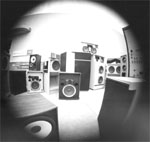No, this is my speaker wire for a system. I used to use 18 gauge magnet wire but I thought I would try something a little heavier. The needed current for these speakers is small, but since the First Watt F1J current source amp can send more power than the small tube amps the speaker designer had in mind for it... A just in case scenario. The 10 gauge on my 4345s is overkill but no harm done there either. As I said elsewhere I have probably spent too much on amplification, but this stuff does have faultless sound. Some day I might throw a cheap 25 watt class D in there and there may not be a difference, who knows.
I have long bucked the trend here and the ancient low power warning JBL paper. I don't play my speakers as loudly as some, and they are so efficient I don't need big watts. In the 98-101 dB category big power only adds inches, and I am content in my manhood without doing that.

Come'on, two watts through these and I need earplugs. Keep the Crowns, glad they like them. Bottom line, 16 AWG is welcome here.
I still think double insulated magnet wire is a first class choice for internal speaker connections, if I ever go there. Compact, stiff and indestructible. Then again that stranded machine tool THHN I found will fill the bill too.





 Reply With Quote
Reply With Quote





